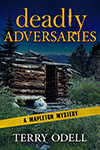By PJ Parrish
The opening line of a book is the single hardest line you write.
Many writers would disagree with that. But for my money, those folks are: A. lucky devils for whom all things come easy; B. diligent do-bees who can scribble down anything just to get started and then go back and rewrite or C. writers who aren’t really very good at what they do or maybe are just phoning it in.
I know, that sounds a little harsh. But I truly believe this. I have such respect and, yes, envy for writers who create great openings. I am not talking about “hooks.” Hooks are easy. I am firmly of the mind that anyone can write a decent hook. You’ve seen them, those clever one-liners tossed out by wise-ass PIs, those archly ironic first-person soliloquies, those purple-prose weather reports that substitute for mood.
No, not hooks. I’m talking about those rare and glorious opening moments that are telling us, “OO-heee, something special is about to happen here!”
We here at TKZ talk alot about great openings, especially for our First Page Critiques. We worry about whether we should throw out a corpse in the first chapter, whether one-liners are best, if readers’ attention spans are too short for a slow burn beginning.
A great opening goes beyond its ability to keep the reader just turning the pages. A great opening is a book’s soul in miniature. Within those first few paragraphs — sometimes buried, sometimes artfully disguised, sometimes signposted — are all the seeds of theme, style and most powerfully, the very voice of the writer herself.
It’s like you’re whispering in the reader’s ear as he cracks the spine and turns to Page 1: “This is the world I am taking you into. This is what I want to tell you. You won’t understand it all until you are done but this is a hint of what I have in store for you.”
Which is why, this week, I have been staring at a blank computer screen. I am trying to start a new book. (Yeah, I know I told you I am retired, but the urge is still there.) I have a good idea. I have outlined in my head the first couple chapters. But I don’t have a first line.
I sit here, staring at my blank Word document, as that cursed cursor blinks like a yellow traffic light in a bad noir novel. I NEED that one line because it’s not just an opening, it’s a promise. A promise to a reader that what I am about to give them is worth their time, is something they haven’t seen before, is something that is…uniquely me.
Well, shoot. I’m rambling. I’ll let Joan Didion explain it. I have a feeling she gave this a lot more thought than I have:
Q: You have said that once you have your first sentence you’ve got your piece. That’s what Hemingway said. All he needed was his first sentence and he had his short story.
Didion: What’s so hard about that first sentence is that you’re stuck with it. Everything else is going to flow out of that sentence. And by the time you’ve laid down the first two sentences, your options are all gone.
Q: The first is the gesture, the second is the commitment.
Didion: Yes, and the last sentence in a piece is another adventure. It should open the piece up. It should make you go back and start reading from page one. That’s how it should be, but it doesn’t always work. I think of writing anything at all as a kind of high-wire act. The minute you start putting words on paper you’re eliminating possibilities.
Didion gave this interview around the time she published her great memoir after her husband’s death The Year of Magical Thinking. The first line of that book is: “Life changes fast.”
Maybe I am more hung up than usual on openings because I have read some really bad opening lines. I won’t embarrass the writers here because they are still alive and I believe in karma. Oh what the hell, I will give you one because this writer deserves to be shamed:
As the dark and mysterious stranger approached, Angela bit her lip anxiously, hoping with every nerve, cell, and fiber of her being that this would be the one man who would understand – who would take her away from all this – and who would not just squeeze her boob and make a loud honking noise, as all the others had.
Okay, I cheated. That is one of the winners from the Bulwer-Lytton bad writing (on purpose) contest. But didn’t you believe for just a moment there it was real?
Let’s move on to some good stuff. Right now, I am re-reading Jeffrey Eugenides’s Middlesex. Look at his opening line:
I was born twice: first, as a baby girl, on a remarkably smogless Detroit day in January of 1960; and then again, as a teenage boy, in an emergency room near Petoskey, Michigan, in August of 1974.
There, in that one deceivingly simple declarative sentence lies the all tenderness, irony and roiling epic scope of Eugenides’s story. And I don’t even care that he used semi-colons.
And then there’s this one:
The village of Holcomb stands on the high wheat plains of western Kansas, a lonesome area that other Kansans call “out there.”
That’s from Truman Capote’s In Cold Blood. This is the first line of a long paragraph of description that opens the book, yet look at what it accomplishes — puts us down immediately in his setting, conveys the book’s bleak mood and hints with those two words “out there” that he is taking us to an alien place where nothing makes sense — the criminal mind.
What is so terrifying about openings, I suppose, is that you only have so much space to work with. And, as Didion said, once you’ve moved deeper into that first chapter, that golden moment of anticipation is gone and then you are busily engaging all the gears to move the reader onward.
I read a lot of crime novels. I do this to keep up with what’s going on in our business but I also do it out of pleasure. But too many of them rely on cheap hooks. That said, here are a couple good openings from books I pulled off my crime shelf.
- We were about to give up and call it a night when somebody dropped a girl off the bridge. — John D. MacDonald, Darker Than Amber
- They threw me off the hay truck about noon. — James M. McCain, The Postman Always Rings Twice
- The girl was saying goodbye to her life. And it was no easy farewell. — Val McDermid, A Place of Execution.
- I turned the Chrysler onto the Florida Turnpike with Rollo Kramer’s headless body in the trunk, and all the time I’m thinking I should’ve put some plastic down. — Victor Gischler, Gun Monkeys.
Not bad for one-liners. Then there are the more measured openings:
Death is my beat. I make my living from it. I forge my professional reputation on it. I treat it with the passion and precision of an undertaker – somber and sympathetic about it when I’m with the bereaved, a skilled craftsman with it when I’m alone. I’ve always thought the secret of dealing with death was to keep it at arm’s length. That’s the rule. Don’t let it breathe in your face.
But my rule didn’t protect me.
That’s from Mike Connelly’s The Poet and it works because it succinctly captures his protagonist’s voice and the theme of the story.
I think this blog post has been therapeutic for me. I think I am going to quit obsessing about the first line and just get the story up and moving. The more I get to know my characters, the more they will open up to me. Maybe one of them will whisper that golden opening line. I can’t remember the exact quote, but Joyce Carol Oates has said that until she knows the ending of her story, she doesn’t know how to start.
I get that. As weird and convoluted as this might sound, sometimes you have to write the last line before you can write the first. Sort of like Picasso signing his painting. Because what a great opening but the writer’s true signature?


 One of my college roommates, Rick, got a bike. One day I asked him if I could try it. He showed me the basics of clutch and throttle. No problem. At the time I was driving my dad’s old three-on-the-tree Ford Maverick. I knew the drill.
One of my college roommates, Rick, got a bike. One day I asked him if I could try it. He showed me the basics of clutch and throttle. No problem. At the time I was driving my dad’s old three-on-the-tree Ford Maverick. I knew the drill.


 Recently, James Scott Bell
Recently, James Scott Bell 













 (Oh, and if I can take a moment for some BSP. Double Intrigue my international romantic suspense set against the Danube river cruise I took last December is now
(Oh, and if I can take a moment for some BSP. Double Intrigue my international romantic suspense set against the Danube river cruise I took last December is now
 Like bang for your buck? I have a
Like bang for your buck? I have a 







 Back when I was doing the Mount Hermon Christian Writers Conference every year, I read a lot of manuscript excerpts for critique. One year I read the opening chapters of a fellow’s first attempt at a novel. He gave me the pitch and was obviously enthused about the idea. He’d had it for years, in fact, and was finally getting it down on paper (as we used to say). I marked up the MS for him and gave him some tips.
Back when I was doing the Mount Hermon Christian Writers Conference every year, I read a lot of manuscript excerpts for critique. One year I read the opening chapters of a fellow’s first attempt at a novel. He gave me the pitch and was obviously enthused about the idea. He’d had it for years, in fact, and was finally getting it down on paper (as we used to say). I marked up the MS for him and gave him some tips.